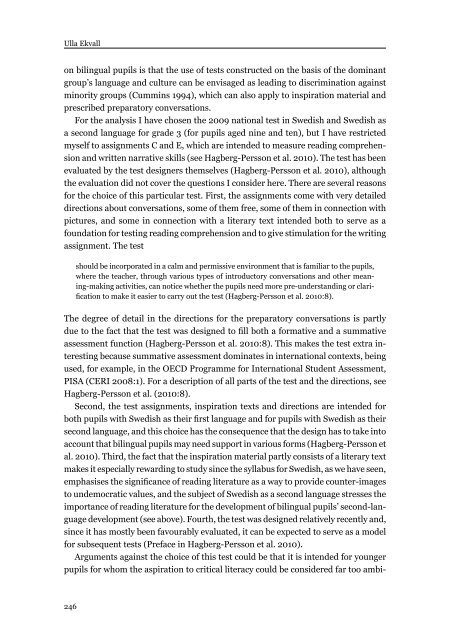Download issue - Umeå universitet
Download issue - Umeå universitet
Download issue - Umeå universitet
Create successful ePaper yourself
Turn your PDF publications into a flip-book with our unique Google optimized e-Paper software.
Ulla Ekvall<br />
on bilingual pupils is that the use of tests constructed on the basis of the dominant<br />
group’s language and culture can be envisaged as leading to discrimination against<br />
minority groups (Cummins 1994), which can also apply to inspiration material and<br />
prescribed preparatory conversations.<br />
For the analysis I have chosen the 2009 national test in Swedish and Swedish as<br />
a second language for grade 3 (for pupils aged nine and ten), but I have restricted<br />
myself to assignments C and E, which are intended to measure reading comprehension<br />
and written narrative skills (see Hagberg-Persson et al. 2010). The test has been<br />
evaluated by the test designers themselves (Hagberg-Persson et al. 2010), although<br />
the evaluation did not cover the questions I consider here. There are several reasons<br />
for the choice of this particular test. First, the assignments come with very detailed<br />
directions about conversations, some of them free, some of them in connection with<br />
pictures, and some in connection with a literary text intended both to serve as a<br />
foundation for testing reading comprehension and to give stimulation for the writing<br />
assignment. The test<br />
should be incorporated in a calm and permissive environment that is familiar to the pupils,<br />
where the teacher, through various types of introductory conversations and other meaning-making<br />
activities, can notice whether the pupils need more pre-understanding or clarification<br />
to make it easier to carry out the test (Hagberg-Persson et al. 2010:8).<br />
The degree of detail in the directions for the preparatory conversations is partly<br />
due to the fact that the test was designed to fill both a formative and a summative<br />
assessment function (Hagberg-Persson et al. 2010:8). This makes the test extra interesting<br />
because summative assessment dominates in international contexts, being<br />
used, for example, in the OECD Programme for International Student Assessment,<br />
PISA (CERI 2008:1). For a description of all parts of the test and the directions, see<br />
Hagberg-Persson et al. (2010:8).<br />
Second, the test assignments, inspiration texts and directions are intended for<br />
both pupils with Swedish as their first language and for pupils with Swedish as their<br />
second language, and this choice has the consequence that the design has to take into<br />
account that bilingual pupils may need support in various forms (Hagberg-Persson et<br />
al. 2010). Third, the fact that the inspiration material partly consists of a literary text<br />
makes it especially rewarding to study since the syllabus for Swedish, as we have seen,<br />
emphasises the significance of reading literature as a way to provide counter-images<br />
to undemocratic values, and the subject of Swedish as a second language stresses the<br />
importance of reading literature for the development of bilingual pupils’ second-language<br />
development (see above). Fourth, the test was designed relatively recently and,<br />
since it has mostly been favourably evaluated, it can be expected to serve as a model<br />
for subsequent tests (Preface in Hagberg-Persson et al. 2010).<br />
Arguments against the choice of this test could be that it is intended for younger<br />
pupils for whom the aspiration to critical literacy could be considered far too ambi-<br />
246

















